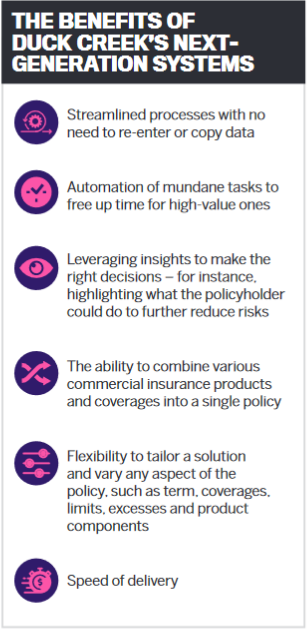

Insurance brokers and their customers live in a digital world where almost everything can be achieved online, whether it’s buying tailored computers, getting real-time assessment of current computer specifi-cations, leveraging expert advice or obtaining consumer recommendations. The consumer chooses the channel and can swap seamlessly between them throughout the life cycle.
Yet many brokers and customers feel frus-trated that they’re not enjoying this customer- centric, digital, omnichannel experience in their daily work, says Johan Nelis, director of solution consulting for APAC at Duck Creek Technologies. Getting insurance still involves a plethora of paper forms and many manual, repeatable, and mundane tasks.
“We feel that insurance should also be digital, enabling brokers to better service their customers,” Nelis says.
Duck Creek provides core system solu-tions (Rating, Policy, Billing, Claims and Insights) to the general insurance industry, which are available either as stand-alone products or as a full suite of systems. The company’s on-demand SaaS delivery solution allows insurers to launch new products more quickly and allows the technology to support the business strategy rather than dictating it, Nelis says. He adds that systems like this are the next generation because the imperative to be creative and adaptable is only growing.
Founded by brokers in the US in 2000, Duck Creek’s aim from the get-go has been to create insurance solutions that put brokers and clients front and centre. The company designed its innovative suite of software products to bring transparency, integration and consistency to insurance – and, crucially, put the insurer in control. “Digital insurance is driven by the expec-tations, requirements and capabilities of the three parties involved: customer, broker and insurer,” Nelis says. “We see customers are looking for a consistent experience across all channels, an e ortless service experience at every touchpoint throughout the journey and a personalised experience.”
He gives the hypothetical example of a baker who is busy opening another branch and has limited time to enter data – and finds it hugely frustrating having to fi ll in infor-mation the broker or insurer already has. With next-generation technology like Duck Creek’s, the baker only has to give his broker limited information related to his business, property and vehicles, which is then used to obtain all relevant underwriting data.
If the baker buys an asset like a donut production line, he gets a prompt asking whether he wants to add this equipment to his policy. He has also installed an IoT device near the production line’s water boiler that gets a message as soon as a leak is detected, flagging the need for immediate assistance and triggering the initiation of a claim.
As for brokers, they need quick turna-round times and access from any channel (desktop, mobile, in person); a simple and user-friendly quote, buy and service experi-ence; and targeted information or content to best service customers.
Nelis gives the example of a broker who wants to o er a cyber insurance product with a unique set of coverages, limits and excess.
She wants to be able to sit down with clients and go through the options on her tablet and get instant feedback on pricing, coverage limits and excess. By connecting to an underwriter who can see the screen and provide real-time updates, the broker can make pricing and underwriting decisions within her authority. She can also access aggregate insurance information from similar busi-nesses (much like Amazon’s ‘people like you bought’ model), allowing her to tailor her advice.
Flexibility is also key, Nelis says – the ability to make a modifi cation if the market asks you to go in a di erent direction.
“Insurance is evolving,” he says, “so you can’t design everything for the next five to 10 years; rather, you need a platform that has the right architecture that is nimble, with the ability to quickly make changes with minimal effort and risk; connected to a broader ecosystem of ever-increasing third-party solutions that will enhance your o ering; and smart – able to leverage data to streamline and improve your processes and outcomes.”
He adds that insurers need digital tools “to provide omnichannel experience for brokers and customers – enhanced experi-ence leveraging automation, digitization and integration – and provide predictive analytics that assist brokers and customers throughout all facets of insurance”.
Nelis notes that insurers should also leverage third-party data to get better insights into the underwriting risk. To return to the example of the baker, brokers could assess the business’s cyber risk through auto-mated scanning of all of the client’s digital assets and identify shortcomings that prevent or limit risks and reduce the premium. For example, the behaviour of the baker’s delivery drivers could determine the premium and/or excess for his fleet and provide a dashboard with the telematics scores of each driver.
Typically, insurers have struggled to provide this type of tailoring to the customer and broker because they were hampered by legacy systems with high total cost of owner-ship and limited fl exibility. Many insurers have tried to overcome this by commod-itising their insurance o ering, at the cost of catering to unique customer requirements.
“When we talk about legacy systems, we shouldn’t just be thinking about the decade-old mainframes, but also newer solutions that aren’t flexible once installed,” Nelis says. “We heard of an occasion where an insurer using a legacy system took three months and spent more than $1m to not ask a question in the process.”
In the past, it was common for insur-ance system vendors to dictate how business had to be run on their system. If a business wanted to offer more flexible and innova-tive solutions, Nelis says, it had to break the system to do that. 
“But now you see more insurers saying, ‘This is how I want to set up my products and process’,” he says. “Our solution allows you to say, ‘This is what the insurance offering is’, and then, because the system is descriptive, it’s easier for IT to deliver.”
Typically, digital change in the industry has been sluggish because upgrading an insurance system is an expensive and time-consuming affair. But with a cloud-based solution such as Duck Creek’s, where a system is updated rather than upgraded, any amendments are almost instant.
Digitalisation has already disrupted many sectors, Nelis says, and the insurance industry is no different.
“The local video store has disappeared, and the local travel agency has transformed into an adviser to survive,” he says. “The insurance industry is also being disrupted – take, for example, Amazon offering insurance to its Amazon Business Prime customers – hence the need for brokers to demon-strate their value and need for insurers to be more responsive.”
COVID-19 has also highlighted some of the industry’s anachronistic ways of working.
“We spoke with an insurer who stated that their staff couldn’t work without the physical files; during the pandemic, their entire work-force embraced digital within a year and have experienced the benefits,” Nelis says. “While insurance has been around for hundreds of years, customers’ needs are evolving at an ever faster pace. You need to find ways, as insurers and brokers, to ensure you continu-ously provide value.”
